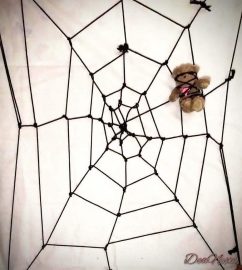I was recently asked a very good question by someone relatively new to rope, regarding how to manage the emotional impacts whilst untying a rope bottom. In that discussion, and in many similar ones with other people, it occurred to me just how little emphasis we put on the untying process.
Which is sad. Because, in my experience, the untying part of the rope experience can be a very special moment indeed.
Now, I do appreciate that people have different intentions in their rope. Particularly if you are seeking to model or tie a model to create visual imagery as an art form, having that option of the rope scene being solely or predominantly about creating images is a valid thing to do. I’ve done that. It’s good fun. But rope can be a very visceral and organic experience, so negotiations need to be very tight on that.
Rope does literally and figuratively pull people together. It has the potential to create deeper connection as you explore the effects that rope has on you and your partner, tied or tier. Once you have negotiated and established consent of what will happen, the ability to swim in the sea of physical and emotional feelings can be deeply pleasurable. Whether you play with bondage, pain, contortions, aesthetics, sensory elements or other factors into your rope scene, no two scenes are ever the same, and so can be deeply fulfilling and ironically liberating.
So, it stands to reason that the removal of rope from the body will have an impact upon both the rigger and bottom. After spending some time creating the tie, perhaps going through transitions with that tie, the unwrapping of ropes signifies the beginning of the end of the scene (usually, depending on your negotiations). Knowing how to navigate those feelings is a really important part of your self care practice, and can enhance your tying scenes. Otherwise, you may experience feelings of anxiety or dread, hampering your ability to let go and feel the moment you are in. Being present, and in the present, enhances the experience manifold.
Furthermore, untying is a deeply sensory experience. If you use jute, for example, there is a vibration in the ropes that is felt less whilst tying, because rope is typically placed on the body, not dragged on the skin (tut tut, bad rigging…. unless you negotiated that into the scene). The rope slowly frees itself from the body, blood rushing back into full circulation, muscles easing back into a natural, relaxed state. The endorphins may slowly decrease, or potentially increase through those physical changes. For a bottom this is a powerful part of the rope experience on the body and mind. For the rigger, it’s equally a carnal yet transcendental experience; the physical exertion coming to the end, the bond felt, the endorphins rushing through our veins. That’s the potential, anyway.
So, points to reflect on:
- How do you usually react in scenes when you untie or are untied?
- How well have you communicated what you feel with your partner?
- How could your untying be improved?
- What are your and your partner’s intentions when you tie?
- How have you previously negotiated the untying part of the rope scene process?
- What marks are OK for you? Where? To what extent?
- Are you neatly packing your ropes away in the scene or waiting until the end? Why?
- Are you forceful to any degree in untying?
- Do you have consent to drag rope across the skin? (Potentially causing a burn)
- Do you wish the rope to be passed across certain parts of the body as part of erotic play?
- What are the expectations after the rope is removed from the body?
- At what point do you feel the scene is over?
- What do you need at the end of the scene?
- How will you engage in a feedback process?
I provide no answers, only questions. This is because you are you. You are an individual, as are the people you engage in rope with. It’s vital to remember that we are all human and will think and feel differently from day to day, even moment to moment, beginning of scene to end of scene. So, be kind and respectful to people’s needs whilst negotiatingand playing. And seek help from peers or health professionals if you need to. We all do at some point or several others!
Cover image: a small Teddy bear tied into a rope cobweb and photographed. by Dea Nexa

2 replies on “When You Untie…”
Excellent!
Thank you!